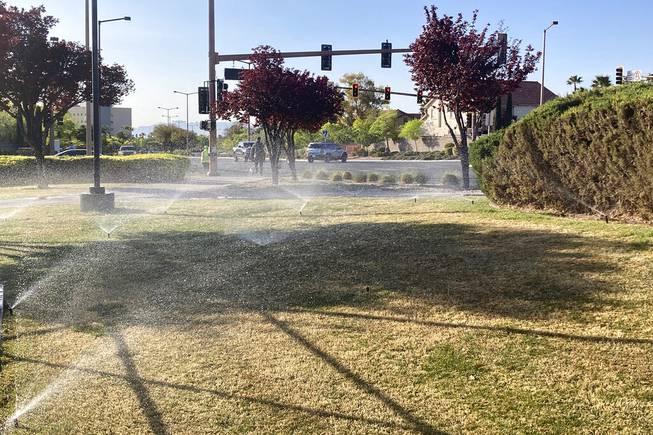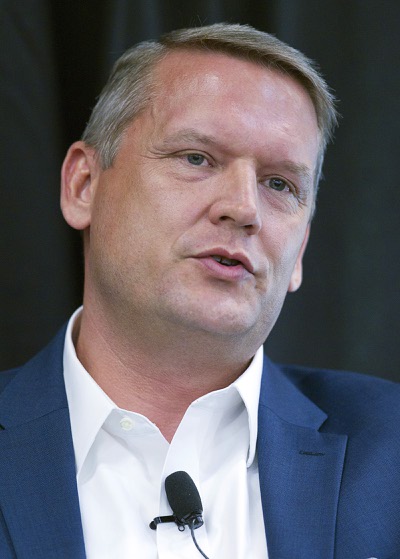
Ken Ritter / AP
In this April 9, 2021, photo, sprinklers water grass near a street corner in a Summerlin neighborhood.
Thursday, Aug. 5, 2021 | 2 a.m.
View more of the Sun's opinion section
Editor’s note: As he traditionally does every August, Brian Greenspun is turning over his Where I Stand column to others this month. In presenting this year’s series of columns from community leaders, we feel it is important that our readers, trying to emerge from the ravages of the pandemic, hear from some of the people who can help guide us to better tomorrows. Today’s guest is John Entsminger, general manager of the Southern Nevada Water Authority.
With Lake Mead’s bathtub ring as the backdrop, ongoing drought conditions in the Colorado River basin have captured the nation’s attention, particularly as the federal government is expected to declare the first-ever shortage on the river. As a result, one question I am asked frequently is whether our community has enough water to sustain our economy into the future.
And, the answer really comes down to one thing: A commitment to water conservation.
While the Southern Nevada Water Authority’s 50-year Water Resource Plan takes into account water demands and population projections — as well as the potential effects of drought and climate change — the plan requires that our community continues its water conservation progress, reducing per-person water consumption annually.
When this historic drought took hold in 2002, Southern Nevada was using more than its legal entitlement of 300,000 acre-feet of Colorado River water. Thanks to the community’s commitment to conservation, we used 23% less Colorado River water last year than we did in 2002, even while adding nearly 800,000 new residents and maintaining a prosperous and robust economy during that same time.
Water use, however, has been increasing over the past few years, and now we face shortage conditions on the Colorado River, which provides 90% of our water supply. These shortage conditions coupled with water reductions from the Drought Contingency Plan will cut our supplies from Lake Mead by 7 billion gallons next year. That’s enough water to supply 45,000 average valley households for one year.
While this is alarming and emphasizes the need for greater water conservation from the community, it is also something we have been preparing for over the past two decades through proactive measures.
Last spring, we completed the low lake level pumping station on time and under budget. This infrastructure project — teamed with a new water intake at the lake’s bottom — ensures access to our water supply even if Lake Mead drops so low that Hoover Dam is unable to generate power or release water to downstream users.
This critical infrastructure also provides opportunities to partner with other basin states to find innovative solutions. For example, we are pursuing a partnership with the Metropolitan Water District of Southern California to develop a water recycling system that will reuse Los Angeles wastewater currently discharged into the ocean. Helping fund the project, we would receive a share of the water, which would be exchanged for an equal share of California’s Colorado River supplies accessed from Lake Mead.
Nearly every drop of Colorado River water that our community uses indoors is already recycled and safely returned to Lake Mead. This extends our water supply by more than 75%. Water used outdoors, however, is only used once, and as we face shortage conditions, we all need to double down on our outdoor conservation.
To that end, a new initiative recently signed into law will prohibit the use of our community’s Colorado River water to irrigate unused, decorative grass in medians, roundabouts, business centers, HOA entrances and areas bordering parking lots and streets by the end of 2026. This will save 9.5 billion gallons of water annually, which equates to 10% of our annual water supply.
Conservation is a journey and not a destination, so every resident and business leader must continue to conserve water by adhering to the mandatory seasonal watering restrictions, reporting water waste and replacing decorative grass with drip-irrigated trees and plants. These efforts are essential to our community’s long-term viability and economic success. And, they work.
Currently, only about 50% of single-family homes comply with the mandatory watering restrictions. Achieving an average seasonal improvement of another 75,000 households following the restrictions — especially in the fall and winter — could yield about 5 billion gallons in additional water savings.
We have the capability, the obligation, and the need to be the most water-efficient community in the nation. It is the responsibility of every Southern Nevadan living and working here to help achieve that goal for our future sustainability.

